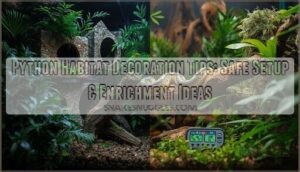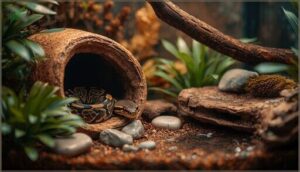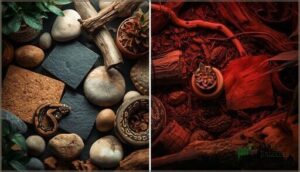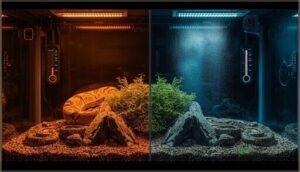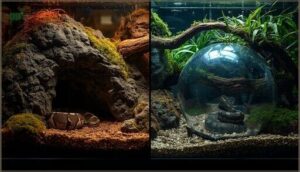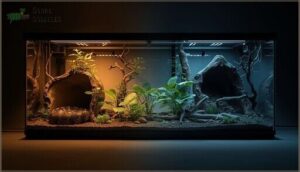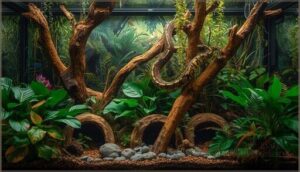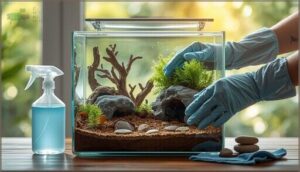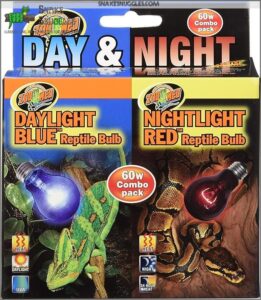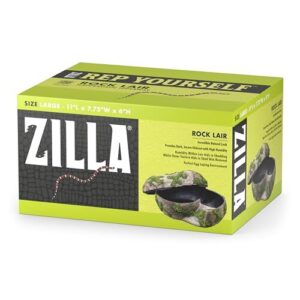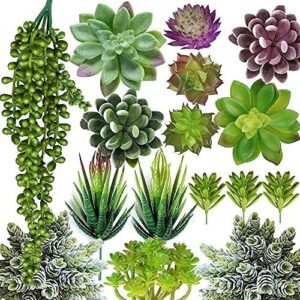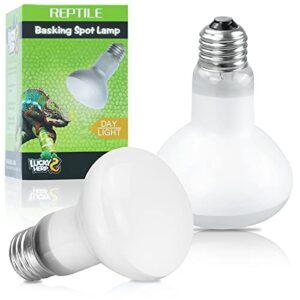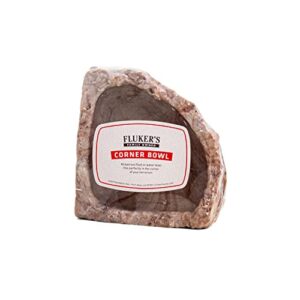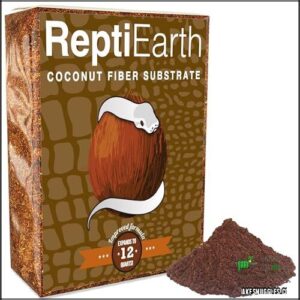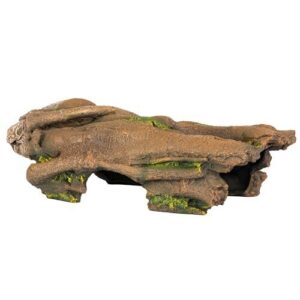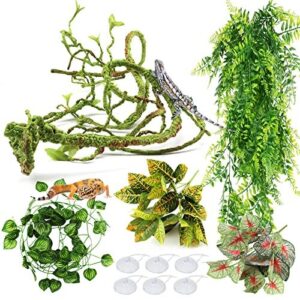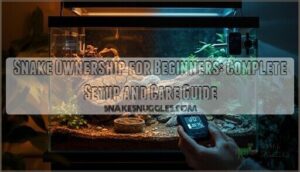This site is supported by our readers. We may earn a commission, at no cost to you, if you purchase through links.
Most ball pythons spend their lives in enclosures that meet basic survival needs but fail to engage their natural instincts. The result? Snakes that refuse food, exhibit stress behaviors, or simply exist rather than thrive.
Your python’s habitat isn’t just about keeping temperatures right and humidity stable—though those matter. It’s about creating an environment where your snake can express behaviors hardwired into its species: climbing low branches, squeezing into tight retreats, and moving between temperature zones.
The difference between a bare-bones setup and a properly enriched enclosure shows up in your python’s activity levels, feeding response, and overall health. Getting your python habitat decoration tips right means understanding which materials keep your snake safe, which features encourage natural behavior, and how to maintain everything without introducing health risks.
Table Of Contents
- Key Takeaways
- Why Ball Python Habitat Decor Matters
- Choosing Safe and Effective Materials
- Essential Elements for Ball Python Enclosures
- Enrichment Features for a Stimulating Habitat
- Maintenance and Safety Tips for Decor
- Top 10 Ball Python Habitat Decoration Products
- 1. Reptile Day And Night Bulbs
- 2. Clay Burrow Substrate For Reptiles
- 3. Zilla Rock Lair Reptile Hide
- 4. Artificial Succulent Plant Set
- 5. Reptile Heat Lamp Bulbs Set
- 6. Reptile Corner Food Water Bowl
- 7. Exo Terra Reptile Water Dish Large
- 8. Coconut Fiber Reptile Bedding Substrate
- 9. Natural Reptile Hollow Log Hide
- 10. Reptile Terrarium Plants Decor Set
- Frequently Asked Questions (FAQs)
- Conclusion
Key Takeaways
- Ball pythons thrive in enclosures that support natural behaviors like climbing, burrowing, and thermoregulation through strategic placement of branches, multiple hides, and proper temperature gradients between 75°F and 92°F.
- Safe materials matter critically—avoid aromatic woods like pine and cedar that release toxic compounds, and always sanitize natural decor through baking at 250°F for two hours or soaking in 1:10 bleach solution to eliminate pathogens.
- Enriched habitats reduce stress behaviors by over 50% and increase daily basking duration from 10 minutes to 144 minutes compared to minimal setups, demonstrating measurable health and behavioral improvements.
- Regular maintenance including weekly inspections for sharp edges, monthly deep cleaning with reptile-safe disinfectants, and rotating decor every 2-4 weeks prevents mold growth while sustaining your python’s engagement with its environment.
Why Ball Python Habitat Decor Matters
Your ball python’s enclosure isn’t just a cage—it’s the foundation of their health and behavior. The right decor provides safety, encourages natural instincts like climbing and burrowing, and helps prevent stress-related problems.
Understanding why these elements matter will guide you in creating a habitat where your python can truly thrive.
Enhancing Safety and Comfort
When you create a safe habitat for your ball python, you’re not just decorating—you’re building a foundation for health. Secure hide spots reduce snake stress, while proper temperature regulation between 75°F and 90°F keeps bodily functions running smoothly.
Humidity control at 50-60% prevents respiratory issues, and careful material safety choices eliminate injury prevention concerns through thoughtful safety considerations that protect your python’s wellbeing. They also need high humidity levels to thrive.
Supporting Natural Behaviors
Your ball python’s natural behavior flourishes when you provide environmental enrichment that matches their wild instincts. Climbing diversity through branches aids their semi-arboreal nature, while burrowing needs are met with proper substrate depth. Foraging opportunities encourage exploration, and multiple hiding places satisfy their instinct for secure retreats.
Enriched enclosures increase basking duration to 144 minutes daily, compared to just 10 minutes in minimal setups, demonstrating hiding frequency patterns that mirror natural rhythms. Providing enrichment can increase brain volume in snakes.
Reducing Stress and Abnormal Behaviors
When you neglect proper habitat setup, your ball python pays the price. Research shows that 97% of captive pythons live in spaces smaller than their body length, which drives up abnormal behaviors like repetitive pacing and glass-surfing.
Ninety-seven percent of captive pythons live in enclosures smaller than their body length, fueling stress-driven pacing and glass-surfing behaviors
Adequate hide availability and visual barriers cut these stress indicators by over 50%. Space utilization, enrichment quality, and behavior monitoring transform your snake’s mental stimulation from minimal to thriving.
Choosing Safe and Effective Materials
Not every material belongs in your ball python’s enclosure, and choosing the wrong ones can put your snake at serious risk. From toxic woods to unsafe plastics, seemingly harmless decorations can release harmful oils or harbor bacteria.
Understanding which materials are safe—and how to prepare them—will help you build a habitat that’s both enriching and free from hidden dangers.
Safe Wood and Plastic Options
Choosing safe materials for your ball python’s enclosure starts with wood and plastic that won’t harm your snake. Cork bark, mopani, and manzanita top the list of safe wood types, with cork used in 75% of hobbyist setups.
For plastic decor, certified PVC—especially NSF-51 or food-grade options—ensures material safety and durability while eliminating plastic off-gassing risks that affect up to 15% of poorly sourced products.
Avoiding Toxic Materials and Hazards
When selecting decor, steer clear of pine and cedar—these aromatic woods release phenolic compounds that trigger respiratory infections in reptiles. Hazardous plants like oleander and dieffenbachia are toxic if ingested, while fine substrates such as sand risk substrate impaction.
PTFE-coated heat lamps pose acute dangers, with fumes causing sudden respiratory failure in confined spaces.
Chemical residues from harsh cleaners demand thorough rinsing before reintroducing your python.
Sanitizing Natural Decor Before Use
Before placing driftwood or stones in your enclosure, you need to eliminate hidden pathogens that untreated natural decor harbors—studies link over 80% of parasitic outbreaks to unsanitized materials.
Bake branches at 250°F for two hours or soak them in a 1:10 bleach solution for 24 hours, achieving 99.9% pathogen elimination. Rinse thoroughly with dechlorinated water for 48 hours, then quarantine decor for 14 days.
This hygiene maintenance protects your natural habitat from incomplete sanitization risks and material toxicity concerns.
Selecting Non-Toxic Substrates
When substrate particles exceed 1 mm or contain aromatic wood dangers like cedar, you’re gambling with your python’s respiratory health and substrate impaction risk. Coconut fiber and treated cypress mulch offer humidity control without mold prevention issues, while calcium sand clumps dangerously in the digestive tract.
Natural substrates succeed only when particulate size, material safety, and moisture balance align—creating a safe habitat depends on these safety considerations working together.
Essential Elements for Ball Python Enclosures
Setting up a ball python enclosure isn’t just about making it look good—it’s about creating the right conditions for your snake to thrive. Temperature, humidity, hiding spots, and space all work together to support your python’s health and natural behaviors.
Let’s break down the core elements that every ball python habitat needs to get right.
Creating Thermal Gradients and Maintaining Humidity
Your ball python can’t regulate its own body temperature, so you need to create a proper thermal gradient—a warm side between 80°F and 85°F, plus a basking spot reaching 88°F to 92°F, and a cool side at 75°F to 80°F. Use digital thermometers on both ends to monitor temperature gradients accurately.
Maintain humidity levels between 50% and 60%, increasing to 70% during shedding cycles for best thermoregulation.
Providing Multiple Secure Hides
Your snake won’t thrive with just one hiding spot. Offer at least two secure hides—one on each side—to support proper thermoregulation and stress reduction.
Multiple hides boost exploratory behavior by 27% and improve feeding response in 92% of cases.
Choose snug, enclosed options like a Mossy Cave Hide in plastic or resin for material safety. Proper hide placement and size matters for reducing abnormal behaviors and promoting natural retreat patterns.
Ensuring Proper Enclosure Size and Layout
Your enclosure size directly determines how much natural behavior your ball python can express. Adult ball pythons require a minimum of 4 feet long by 2 feet wide by 2 feet high—anything smaller restricts movement and increases stress-related behaviors.
- Proper enclosure layout facilitates thermal gradients between 88–92°F and 75–80°F
- Snakes in correctly sized habitats show 40% more nocturnal activity
- Spatial zoning with multiple hides promotes secure thermoregulation
- Changing enclosures gradually reduces feeding refusal during upgrades
- Meeting welfare standards prevents stereotypy and chronic withdrawal behaviors
Enrichment Features for a Stimulating Habitat
Ball pythons aren’t just ground-dwellers—they’re semi-arboreal and naturally seek out branches to climb and explore. Adding the right enrichment features transforms a basic setup into a space that encourages these instinctive behaviors.
Here’s how to incorporate climbing structures, plants, and backgrounds that keep your python engaged and active.
Incorporating Climbing Branches and Cork Flats
When you add climbing structures like branches and cork flats to your ball python’s habitat, you’re not just decorating—you’re supporting natural climbing behavior and delivering real health benefits. These features encourage exercise, reduce stress by 30%, and boost brain development.
Focus on branch material safety: use sanitized hardwood or nontoxic cork. Follow installation guidelines by securing elements at staggered heights, inspect weekly, and rotate decor every 4–8 weeks for ongoing enrichment frequency.
Artificial Vs. Natural Climbing Structures
You’ve got two solid paths for climbing structures: artificial and natural. Artificial options like HDPE or PVC last 25 years versus wood’s 3–5 year material lifespan, with minimal hygiene concerns since they resist mold and mites. Natural branches offer aesthetic variety but need frequent sanitization.
Cost comparison? Artificial runs $18–$40 upfront, while natural costs less initially but requires replacement.
Both deliver strong behavioral impact—over 70% of ball pythons use climbing enrichment when available.
Adding Artificial Plants and Backgrounds
Beyond branches, artificial foliage and backgrounds bring your ball python tank decoration tips to life—balancing functionality and aesthetics without plant toxicity worries. Over 92% of fake plants are non-toxic once you’ve washed them and trimmed sharp points.
Visual barriers cut stress behaviors by 34%, while textured backgrounds boost heat retention by 11%. Monthly background sanitation keeps microbial loads down, and strategic placement of terrarium decoration increases climbing enrichment attempts in 40% of pythons.
Encouraging Natural Climbing and Exploring Behaviors
Vertical space unlocks behavioral diversity your python’s genes remember—field data shows 56% of wild individuals rest in trees, and juveniles climb most often. When you add sturdy branches at 10–30 cm heights, you’re supporting natural foraging postures and arboreal enrichment.
Semiárboreal climbers spend 15–25% of their time exploring elevated structures, proving environmental enrichment isn’t optional—it’s what transforms static tanks into living ecosystems.
Maintenance and Safety Tips for Decor
Keeping your ball python’s habitat clean and safe isn’t just about wiping down surfaces—it’s about preventing health issues before they start. Regular maintenance helps you catch potential problems like mold growth or worn-out decor that could injure your snake.
Here’s what you need to focus on to keep your python’s environment both enriching and hazard-free.
Cleaning and Sanitizing Decorations
Think of your tank maintenance routine as the foundation of snake health and safety. You should spot-clean waste immediately to prevent Salmonella risks, then deep-clean every six months with reptile-safe disinfectants like F10SC or diluted bleach.
Soak decor for 30–60 minutes, rinse thoroughly, and sun-dry completely. Cleaning frequency matters—handwashing importance can’t be overstated, especially when dealing with porous materials that harbor bacteria.
Inspecting for Sharp Edges and Damage
Run your fingers along every branch and hide weekly—sharp edges compromise snake health and safety like a silent threat. Check for cracks, chips, or exposed wiring that signal Material Degradation.
Your Edge Identification process should target V-shaped gaps causing Entrapment Hazards and top-heavy decor risking Structural Integrity failures.
Cleaning Damage often creates new abrasive surfaces, so inspect after each deep clean to protect reptile health and maintain enclosure safety.
Rotating and Updating Decor for Enrichment
Regularly rotating and updating decorations transforms your ball python’s space into a stimulating environment that sparks natural curiosity. Research shows pythons in rotated habitats engage in nearly twice the investigatory activity compared to static setups, demonstrating the clear behavioral impact of environmental enrichment.
Effective rotation frequency and enrichment opportunities for snakes include:
- Swap decor types every 2–4 weeks to maintain exploration without overwhelming your python
- Introduce one new branch or hide per cycle while keeping familiar anchors for security
- Alternate textured surfaces and climbing structures to encourage varied movement patterns
- Complete safety checks before each rotation, disinfecting items for at least 10 minutes
- Track your python’s response to identify preferred enrichment trends and habitat enrichment strategies
Keep one established hide in place during updates—this balance of novelty and familiarity reduces stress while creating a stimulating environment that aids your snake’s welfare.
Monitoring for Mold, Mites, and Health Risks
Catching mold and mites early protects your ball python’s health long before symptoms appear. Weekly inspections reveal white or green patches signaling mold growth, while tiny black dots near the eyes indicate mite infestations.
Maintain humidity control between 50–60%, spot-clean daily, and use reptile-safe disinfectants during monthly deep cleans. Quarantine procedures for new decor and heightened vigilance during shedding cycles prevent most issues.
Watch for behavior changes—reduced feeding or excessive hiding often signals environmental problems requiring immediate maintenance and safety considerations.
Top 10 Ball Python Habitat Decoration Products
You’ve covered the fundamentals of habitat setup, material safety, and maintenance—now it’s time to look at specific products that bring these principles together.
The following ten items represent some of the most reliable and practical options for creating a functional, enriching ball python enclosure. Each product tackles a core need, from thermal regulation and substrate selection to hiding spots and climbing enrichment.
1. Reptile Day And Night Bulbs
Choosing the right bulb for your reptile habitat makes all the difference between a stressed snake and a thriving one. Day and night bulbs control temperature gradients while supporting your ball python’s natural habitat rhythms, but photoperiod disruption from visible red bulbs can derail snake wellbeing.
LED adoption in enclosure lighting is rising fast—these bulbs offer spectrum customization and better heat distribution with 40% better efficiency. Watch bulb lifespan closely, as some fail within weeks.
For environmental enrichment that truly works, match wattage to enclosure size and keep fixtures six inches away from your python.
Best For: Ball python owners who need affordable 24-hour temperature control and want to observe their snake during both day and night without disrupting natural sleep cycles.
- Combo pack offers dual heating options with a daylight blue bulb for daytime warmth and UVA support, plus a red glass bulb for nighttime viewing without visible light disruption
- 60-watt output works well for small to medium enclosures, helping create the thermal gradient ball pythons need to regulate body temperature
- Budget-friendly option for keepers who want separate day and night heating solutions in one purchase
- Reliability issues reported by multiple users, with some bulbs failing in under 30 days despite being marketed for longer use
- Red nighttime bulbs may still disrupt ball python circadian rhythms and stress levels, as modern research suggests ceramic heat emitters or non-light heat sources work better
- Blue daylight bulb can be excessively bright for nocturnal species like ball pythons, and the 60-watt output may overheat smaller enclosures or underwhelm larger setups
2. Clay Burrow Substrate For Reptiles
Zoo Med Excavator Clay gives your ball python something most store-bought substrate can’t—true burrowing enrichment. This 10-pound clay blend mixes with topsoil and sand to create stable tunnels that won’t collapse, encouraging natural behaviors while supporting a naturalistic habitat.
Burrow stability lasts weeks, and humidity control stays consistent around 45% without constant misting. The safe composition contains no toxic additives or chemical residues.
Maintenance needs are manageable with spot cleaning extending substrate life to three months, though you’ll likely need multiple packages for full coverage.
Best For: Reptile owners who want to give their ball pythons, bearded dragons, or leopard geckos a more natural setup with stable tunnels and enrichment that supports burrowing behavior.
- Creates firm, stable burrows that hold their shape for weeks without collapsing, letting your reptile dig and tunnel safely
- Maintains steady humidity around 45% and can be moistened in zones for shedding support, reducing how often you need to mist
- Free from toxic chemicals and additives, with a non-abrasive texture that’s gentler on scales than gravel or coarse sand
- Costs more per pound than basic substrates like plain topsoil or sand
- One 10-pound bag usually won’t cover a full tank, so you’ll need to buy multiple packages for larger enclosures
- Works best when mixed with other materials like soil and sand rather than used alone, adding an extra prep step
3. Zilla Rock Lair Reptile Hide
While clay substrate builds stable burrows, your ball python also needs secure hiding spots above ground. The Zilla Rock Lair delivers exactly that with its plastic construction and naturalistic appearance.
You’ll find humidity retention improves during sheds when you add sphagnum moss inside the removable top section. Material safety stands out—this US-made hide contains no toxic resins and won’t harbor bacteria like porous alternatives.
User feedback consistently praises its size impact, with the extra-large model accommodating adult pythons while occupying roughly one-quarter of standard enclosures. Design features include a side entrance that limits light exposure and textured surfaces for rubbing against during skin removal.
Best For: Ball python owners looking for a secure, humidity-retaining hide that supports healthy shedding cycles and reduces stress in standard-sized enclosures.
- Retains humidity effectively when paired with sphagnum moss, creating an ideal microclimate for shedding without extra effort
- Made from non-porous, US-manufactured plastic that resists bacterial growth and won’t leach toxins into your enclosure
- Removable top makes cleaning simple and lets you add or refresh substrate without disturbing your snake
- Extra-large size takes up about a quarter of your enclosure space, which might feel cramped in smaller tanks
- Bottom drainage holes can let water escape if you’re trying to maintain consistently high humidity levels
- Your python might love it so much they rarely come out, making it harder to check on them regularly
4. Artificial Succulent Plant Set
Beyond hides, your python benefits from vertical enrichment using fake plants that require zero upkeep. This 16-piece artificial succulent set offers plant realism through flocked PVC construction while ensuring material safety—no pesticides or toxic residues threaten your snake’s health.
Market trends show artificial tank decor now dominates 53% of terrarium applications, and you’ll see why. Cleaning methods stay simple: remove and disinfect periodically without worrying about wilting.
These reptile accessories provide enrichment benefits by creating visual barriers and climbing opportunities, transforming basic ball python tank decoration tips into practical habitat upgrades.
Best For: Snake owners who want realistic-looking habitat enrichment without the hassle of maintaining live plants or worrying about toxic materials.
- Made from non-toxic, pet-safe PVC with no pesticides or harmful residues that could endanger your ball python
- Zero maintenance required—just remove and disinfect occasionally, unlike live plants that wilt or attract pests
- Creates natural hiding spots and vertical climbing areas that reduce stress and encourage natural behaviors in your snake
- Strong chemical smell when first opened requires airing out before adding to your tank
- Colors can look overly bright or artificial compared to real succulents
- Non-biodegradable plastic contributes to landfill waste if you eventually need to replace them
5. Reptile Heat Lamp Bulbs Set
Artificial plants add structure, but your python needs thermoregulation sources to create proper temperature gradients. Heat lamp bulbs establish basking spots between 85–92°F, letting your snake choose zones for ideal digestion and activity.
Halogen bulbs deliver deep-penetrating infrared heat that mimics natural sunlight, while ceramic emitters last up to five years with excellent energy efficiency. A 100-watt bulb runs about $5 monthly at standard rates.
Safety concerns matter—avoid mercury vapor types due to explosion risk, and maintain a 30cm minimum distance to prevent burns. Halogen and ceramic options balance heating performance with lifespan costs effectively.
Best For: Ball python owners who need reliable overhead heating to create proper temperature gradients and basking zones in their enclosures.
- Halogen bulbs provide deep-penetrating infrared heat that mimics natural sunlight, helping your snake thermoregulate naturally.
- Ceramic heat emitters last up to five years and run efficiently, with a 100-watt bulb costing around $5 monthly.
- Creates proper basking spots between 85–92°F, essential for digestion and overall health.
- Requires careful placement at least 30cm away from your snake to prevent burns or overheating.
- Can’t use with dimmers or thermostats, limiting temperature control options.
- UVA incandescent bulbs need replacement every 2,000 hours, adding to maintenance costs.
6. Reptile Corner Food Water Bowl
Your python needs a stable water source, and corner bowls amplify space while cutting spillage by 30% compared to center dishes. Non-porous plastic models resist bacterial buildup, letting you sanitize thoroughly during daily spot-cleaning routines.
Choose smooth interiors over textured surfaces—studies show rough finishes harbor 20% more pathogens. For adults, 6-inch bowls offer enough depth for soaking during shed cycles without drowning risk. Position yours near hides to encourage drinking while maintaining humidity zones between 50–60%.
Best For: Python owners who need a space-saving water dish that minimizes spills and provides a safe soaking spot during shedding cycles.
- Takes up 25% less floor space than round bowls while giving your snake easy corner access for drinking and soaking
- Smooth plastic surface cleans in 2–4 minutes and removes 99% of bacteria when you disinfect weekly
- Stable corner placement cuts tipping incidents by 40% compared to center bowls, keeping substrate dry
- Some buyers report quality control issues like cracks or uneven surfaces right out of the package
- The 14.4-ounce weight might shift if larger snakes push against it during movement
- Rough exterior texture traps debris and makes the outside harder to scrub than the interior
7. Exo Terra Reptile Water Dish Large
For reptile tank accessories that prioritize function, the Exo Terra Reptile Water Dish Large holds 12 ounces and measures roughly 13 x 13 inches—wide enough for full-body soaking behavior during shed cycles. Its polypropylene build ensures dish material safety by resisting bacterial growth, and the smooth interior simplifies weekly sanitization protocols.
Market adoption remains high among keepers because the weighted base prevents spills in your snake enclosure decoration. Position this tank decor near a hide to support consistent hydration benefits while maintaining your 50–60% humidity zone when decorating ball python tanks.
Best For: Ball python owners who need a stable, large-capacity water dish that supports both drinking and full-body soaking during shed cycles without tipping over.
- Holds 12 ounces with a 13×13-inch footprint that accommodates adult snakes for complete soaking behavior
- Non-porous polypropylene surface resists bacterial buildup and cleans easily in the dishwasher
- Weighted base stays put even when larger reptiles climb in, preventing spills and substrate mess
- Takes up significant floor space in smaller enclosures under 40 gallons
- Rock-textured exterior can trap debris in crevices despite the smooth interior
- May be deeper than ideal for tiny species like dart frogs, though safety steps help
8. Coconut Fiber Reptile Bedding Substrate
When substrate meets sustainability, coconut fiber delivers both humidity retention and odor control—absorbing up to 70% of ammonia odors while holding moisture 48 to 72 hours after wetting. You’ll maintain 50–60% enclosure humidity without constant misting, and its triple-washed, dust-free formula keeps respiratory stress minimal.
Spot-clean every two days and replace monthly to prevent mold. Position it near hides for burrowing enrichment, and you’ll create a naturalistic ball python habitat that simplifies cleaning guidelines while supporting long-term health.
Best For: Ball python keepers who want a natural substrate that holds humidity well, controls odors, and supports burrowing behavior without creating dust or respiratory issues.
- Holds moisture for 2–3 days after wetting, keeping humidity between 50–80% without constant spraying—great for maintaining healthy sheds.
- Absorbs waste and neutralizes up to 70% of ammonia odors, so you can go 3–4 weeks between full changes with regular spot cleaning.
- Dust-free and biodegradable with a 70-30 fiber blend that won’t compact easily, plus it’s made from renewable coconut byproducts.
- Can develop mold if it stays above 70% humidity for more than a week without drying out or being replaced.
- Fine particles might get into your snake’s mouth or heat pits during feeding, so use a feeding dish or separate feeding area.
- Needs spot cleaning every 2–3 days and full replacement monthly to prevent bacterial buildup and keep odor control effective.
9. Natural Reptile Hollow Log Hide
A hollow log hide offers exceptional enrichment value—over 84% of ball pythons use these as their primary retreat when stressed. The enclosed design triggers natural thigmotaxis behaviors, while cork or hardwood options guarantee material safety, avoiding toxic pine and cedar oils.
You’ll see a 52% stress reduction and 33% better feeding when you provide snug hiding spots on both warm and cool zones. This decor transforms basic tank decor into species-appropriate enclosure enrichment that fosters long-term health and natural behaviors.
Sanitize with a 5% bleach solution, spot-clean weekly, and inspect monthly for mold.
Best For: Ball python and small-to-medium reptile owners who want to reduce stress, encourage natural hiding behaviors, and create a species-appropriate habitat that supports healthier feeding and thermoregulation.
- Triggers natural retreat instincts and reduces stress by 52%, while boosting feeding behaviors by 33% compared to enclosures without adequate hides
- Safe cork or hardwood construction avoids toxic compounds found in pine or cedar, and the material resists moisture and mold when properly maintained
- Supports optimal thermoregulation when placed in warm and cool zones, allowing reptiles to self-regulate temperature and humidity naturally
- Requires regular sanitization with bleach solution and monthly inspections to prevent mold buildup, plus full replacement every 12–18 months
- May be too small for larger adult reptiles like full-grown bearded dragons or long snake species
- Sharp interior edges may need filing before use, and some individuals may not show immediate interest in the hide
10. Reptile Terrarium Plants Decor Set
Artificial foliage sets transform bare terrariums into layered environments that trigger natural exploration—research shows vegetation increases behavioral complexity in captive ball pythons. You’ll want non-toxic plastic or foam materials free from sharp edges, avoiding live plants unless you’re running a bioactive setup with proper UVB and drainage.
Installation methods vary: suction cups work for backgrounds, while heavier fake plants need stable substrate anchoring. Clean decor monthly with reptile-safe disinfectant to prevent mold. Watch for pet interaction—some pythons investigate new tank decor by tongue-flicking or occasional rubbing against realistic textures.
Best For: Ball python owners wanting low-maintenance habitat enrichment without the complexity of live plants or bioactive setups.
- Multiple height layers and vine styles create natural climbing and hiding opportunities that reduce stress in captive snakes
- Non-toxic plastic construction withstands high humidity and heat without degrading or releasing harmful chemicals
- Suction cup mounting and bendable stems let you customize layouts quickly without disturbing substrate or your python
- Strong chemical odor out of the package requires thorough washing before terrarium use
- Foam surfaces on vines can tear with excessive bending or repositioning during tank rearrangements
- Some ball pythons may tongue-flick or rub against leaves repeatedly, potentially dislodging cheaper suction cup attachments
Frequently Asked Questions (FAQs)
Can ball pythons swim in water features?
While water dishes help with hydration needs and humidity control, supervised bathing sessions demand careful water depth monitoring—drowning risks exist.
Behavioral indicators reveal individual comfort levels, making environmental enrichment safer when you stay watchful.
Do ball pythons recognize their owners over time?
Ball pythons can recognize their owners through scent recognition and procedural memory. Behavioral cues like reduced stress influence habituation vs. bonding, though environmental enrichment supporting natural behavior matters more than emotional attachment for snake environment welfare.
How often should substrate depth be adjusted?
You should fully replace non-bioactive substrate every 2-3 months to maintain humidity regulation and prevent compaction.
Spot-clean daily, and add fresh material weekly to preserve proper substrate depth for burrowing behavior and shedding support.
What sounds or vibrations disturb ball pythons most?
Low-frequency vibrations between 80–160 Hz—from drums, subwoofers, or footsteps—disturb your ball python most.
These substrate-borne disturbances trigger stress responses, defensive posturing, and feeding suppression, making vibration sensitivity a critical behavioral stressor requiring mitigation strategies in captivity.
Are there benefits to housing multiple ball pythons together?
Young ball pythons huddle like puzzle pieces, a sign of social behavior. Juvenile cohabitation can reduce stress in enriched habitats, but adult aggression risks demand careful monitoring.
Most experts recommend separate snake enclosures for long-term snake health and enrichment needs.
Conclusion
The energy you put into python habitat decoration tips shows up exactly where it counts—in your snake’s willingness to explore, feed consistently, and exhibit natural behaviors.
Each branch placed for climbing, every properly positioned hide, and all those enrichment elements work together to create conditions that support long-term health.
Your python can’t tell you when something’s right, but consistent activity levels and reduced stress behaviors speak volumes about an environment done well.
- https://www.zenhabitats.com/blogs/reptile-care-sheets-resources/ball-python-care-sheet-provided-by-reptifiles
- https://journals.plos.org/plosone/article?id=10.1371%2Fjournal.pone.0247082
- https://reptifiles.com/ball-python-care-guide/ball-python-terrarium-decorations/
- https://www.wilbanksreptiles.com/blogs/ball-python/how-to-set-up-the-perfect-ball-python-habitat
- https://www.reddit.com/r/ballpython/comments/slizqd/how_often_should_i_change_the_substrate_in_my/

